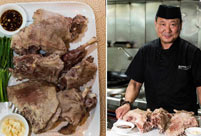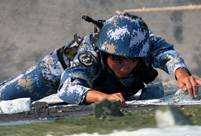 The 4th Chinese National Pole Dance Championship held in Tianjin
The 4th Chinese National Pole Dance Championship held in Tianjin
 Chinese navy commandos debut at 2014 RIMPAC
Chinese navy commandos debut at 2014 RIMPAC
 Guangxi impression: scenic countryside
Guangxi impression: scenic countryside
 World's largest aquatic insect found in Sichuan
World's largest aquatic insect found in Sichuan
 Ceremony volunteers for Youth Olympics make public appearance
Ceremony volunteers for Youth Olympics make public appearance
 A glimpse of female crew of Liaoning aircraft carrier
A glimpse of female crew of Liaoning aircraft carrier
 Stills from "Dad, where are we going?"
Stills from "Dad, where are we going?"
 Legless man's happy life
Legless man's happy life
 Top ten most beautiful islands in China
Top ten most beautiful islands in China
 Aerial view of Hong Kong
Aerial view of Hong Kong
"The region needs to find an internal driving force for growth and nurture its competitive edge by diversifying its products and raising their added value," he said.
Xu Xiaoqing, director of the agriculture department at the Development Research Center of the State Council, pointed out that Heilongjiang grew 4.1 percent in the first quarter, ranking lowest among all provincial-level regions across the Chinese mainland.
Still, Xu said Heilongjiang has taken a leading role in modern agriculture in terms of its farming scale, use of technology and per unit yield, not only in China but also in the world.
However, "besides agriculture, Heilongjiang has no core industries, so slower economic growth is reasonable".
Region 'Should unleash potential'
China's broad northeastern border areas could unleash significant potential by furthering reform and opening-up, said Wei Jianguo, secretary-general of the China Center for International Economic Exchanges.
Russia, South Korea and Japan all are important trading partners and the northeastern border areas have unique regional advantages. However, the development strategy for the region has been a bit conservative and should shift to a more open-minded one in a time of peace, he said.
"China's economy is highly complementary with the Far East area in terms of trade advantages, but the potential hasn't been fully explored," said Wei.
Northeast China has been a major traditional industrial base of the nation with a focus on heavy industry, agriculture and manufacturing. More efforts should be made to tap into the potential of border trade and make these products more popular in neighboring countries.
China has great potential to further cooperate with Russia in terms of land, markets and resources, he said.
China should promote trade in services with these countries.
 |
 Blockbuster? No, it’s firefighters’ posters
Blockbuster? No, it’s firefighters’ posters
 Special 'gifts' for IT men for Chinese Qixi Festival
Special 'gifts' for IT men for Chinese Qixi Festival
 Foreign students' colorful life in China
Foreign students' colorful life in China
 French photographer‘s work 'China 2050' goes viral online
French photographer‘s work 'China 2050' goes viral online A bite of Halal Food
A bite of Halal Food
 Dressed in uniforms to marry you
Dressed in uniforms to marry you
 Female soldier in Chinese special force
Female soldier in Chinese special force
 Zhujiang ambassadors attend lotus lanterns activity
Zhujiang ambassadors attend lotus lanterns activity
 From girly girl to tough special police officer
From girly girl to tough special police officer
 22-year-old veteran travels around China
22-year-old veteran travels around China
 Night scenery of pagoda forests
Night scenery of pagoda forests China suffers from hot summer
China suffers from hot summer 48 hours after super Typhoon Rammasun
48 hours after super Typhoon Rammasun German pianist plays mid-air ‘magic carpet’ show over Munich Airport
German pianist plays mid-air ‘magic carpet’ show over Munich Airport
 China's manned deep-sea submersible conducts dive in Pacific Ocean
China's manned deep-sea submersible conducts dive in Pacific Ocean
Day|Week|Month